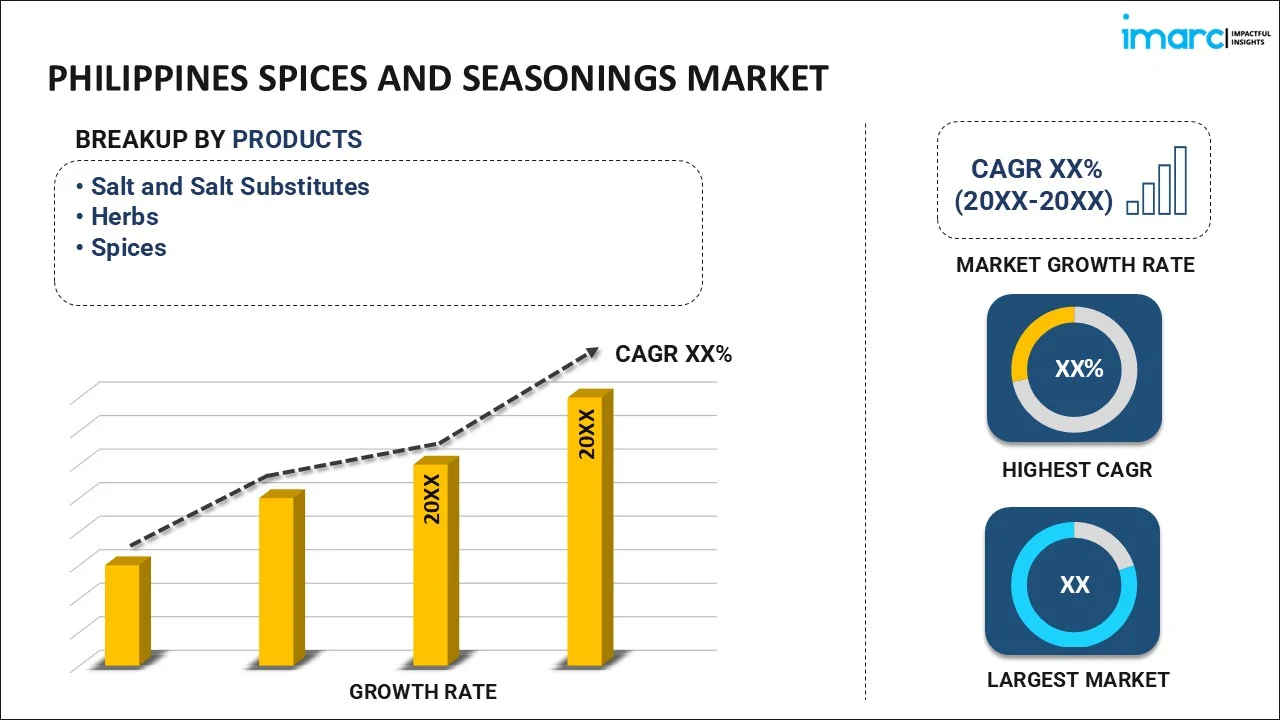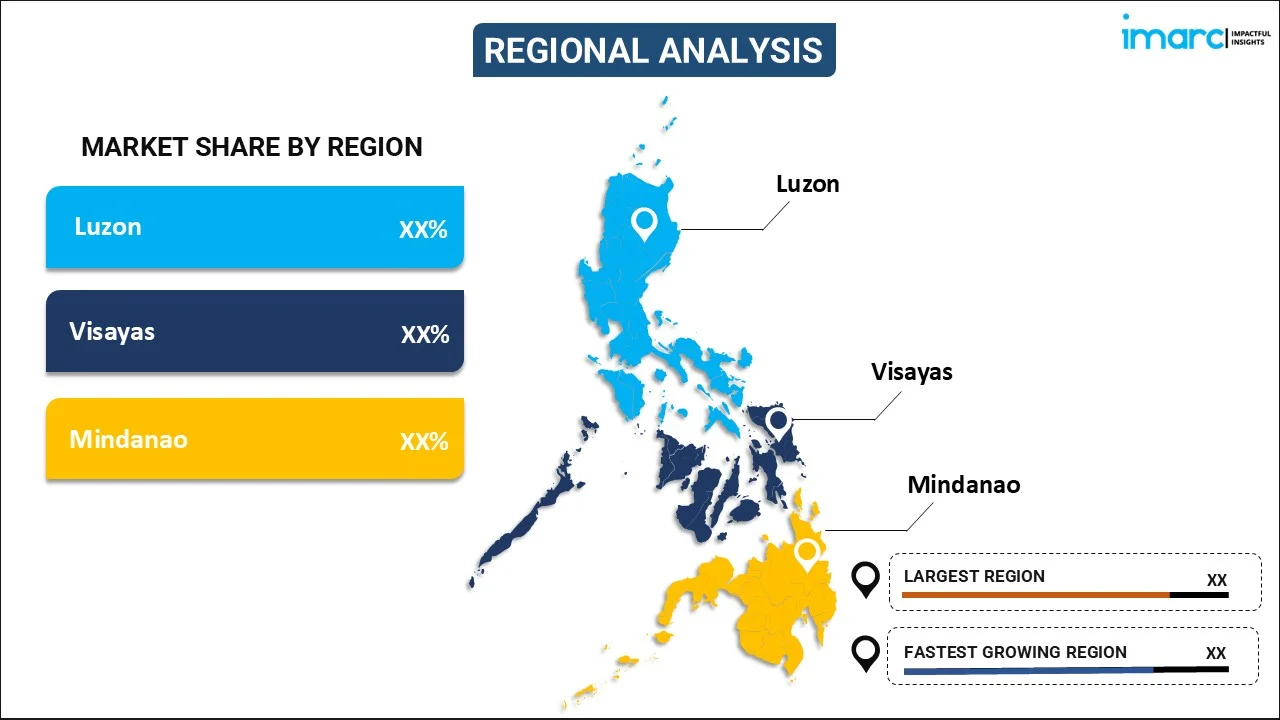
Philippines Spices and Seasonings Market Size, Share, Trends, and Forecast by Product, Application, and Region, 2025-2033
Philippines Spices and Seasonings Market Overview:
The Philippines spices and seasonings market size reached USD 816.90 Million in 2024. Looking forward, IMARC Group expects the market to reach USD 1,527.23 Million by 2033, exhibiting a growth rate (CAGR) of 6.80% during 2025-2033. The market is witnessing stable expansion, boosted by increasing customer requirement for diverse flavors and convenience. Major drivers encompass the notably increased preference for local cuisines, the expanding foodservice segment, and augmenting retail distribution channels, especially online.
|
Report Attribute
|
Key Statistics
|
|---|---|
|
Base Year
|
2024 |
|
Forecast Years
|
2025-2033
|
|
Historical Years
|
2019-2024
|
| Market Size in 2024 | USD 816.90 Million |
| Market Forecast in 2033 | USD 1,527.23 Million |
| Market Growth Rate (2025-2033) | 6.80% |
Philippines Spices and Seasonings Market Trends:
Growing Popularity of Local Flavors and Authenticity
The demand for traditional Filipino spices and seasonings has been steadily increasing as consumers seek authentic and familiar flavors in their meals. Local spices such as siling labuyo (chili pepper), bawang (garlic), and paminta (black pepper) are integral to Filipino cuisine, and there is a growing trend toward incorporating these into both household cooking and foodservice offerings. In response to this trend, companies are increasingly focusing on offering locally sourced and packaged spices that highlight the natural and authentic flavors of the Philippines. Furthermore, the rise of food tourism and social media exposure has driven interest in regional variations of Filipino spices, further boosting the demand for these products. For instance, in June 2024, Government of the Philippines, UN Tourism, and the Basque Culinary Center launched the First UN Tourism Regional Forum, influenced by heightening interest in food amongst travelers actively navigating for authentic food experiences. This initiative would serve as a platform to significantly profit local communities. As a result, local manufacturers are developing innovative spice blends that cater to consumer preferences for traditional and regionally specific seasonings.
Expansion of E-commerce and Retail Channels
The shift toward online shopping has had a significant impact on the spices and seasonings market in the Philippines. For instance, as per industry reports, e-commerce sector in Philippines is exhibiting robust growth and is anticipated to elevate by 19.65 during the year 2024. Consumers are increasingly purchasing their spices and seasonings through e-commerce platforms, which provide greater convenience and access to a wider variety of products. This trend is further supported by the growing penetration of smartphones and improved internet connectivity across the country. For instance, as per industry reports, Philippines has a penetration rate for smartphones around 60.3% in 2024. Retailers are responding by establishing stronger online presences, offering various promotions, and expanding their product ranges. Additionally, brick-and-mortar stores are also adapting by setting up e-commerce operations, enabling consumers to explore and buy products online for home delivery or in-store pickup. This change in consumer purchasing behavior is not only broadening the market reach for spices and seasonings but also allowing brands to introduce new, niche, and premium products to address the evolving consumer tastes.
Philippines Spices and Seasonings Market Segmentation:
IMARC Group provides an analysis of the key trends in each segment of the market, along with forecasts at the country level for 2025-2033. Our report has categorized the market based on product and application.
Product Insights:

- Salt and Salt Substitutes
- Herbs
- Thyme
- Basil
- Oregano
- Parsley
- Others
- Spices
- Pepper
- Cardamom
- Cinnamon
- Clove
- Nutmeg
- Others
The report has provided a detailed breakup and analysis of the market based on the product. This includes salt and salt substitutes, herbs (thyme, basil, oregano, parsley, and others), and spices (pepper, cardamom, cinnamon, clove, nutmeg, and others).
Application Insights:
- Meat and Poultry Products
- Snacks and Convenience Food
- Soups, Sauces and Dressings
- Bakery and Spices and Seasonings
- Frozen Products
- Beverages
- Others
A detailed breakup and analysis of the market based on the application have also been provided in the report. This includes meat and poultry products, snacks and convenience food, soups, sauces and dressings, bakery and spices and seasoning, frozen products, beverages, and others.
Regional Insights:

- Luzon
- Visayas
- Mindanao
The report has also provided a comprehensive analysis of all the major regional markets, which include Luzon, Visayas, and Mindanao.
Competitive Landscape:
The market research report has also provided a comprehensive analysis of the competitive landscape. Competitive analysis such as market structure, key player positioning, top winning strategies, competitive dashboard, and company evaluation quadrant has been covered in the report. Also, detailed profiles of all major companies have been provided.
Philippines Spices and Seasonings Market News:
- In July 2024, Unilever Philippines announced plans to expand the product portfolio of Knorr, its seasoning brand. The company is planning to introduce cooking sauces as an addition to its existing product portfolio.
- In January 2024, Nutrigano Oregano Products announced the launch of its oregano products in Philippines South East Asia.
Philippines Spices and Seasonings Market Report Coverage:
| Report Features | Details |
|---|---|
| Base Year of the Analysis | 2024 |
| Historical Period | 2019-2024 |
| Forecast Period | 2025-2033 |
| Units | Million USD |
| Scope of the Report |
Exploration of Historical Trends and Market Outlook, Industry Catalysts and Challenges, Segment-Wise Historical and Future Market Assessment:
|
| Products Covered |
|
| Applications Covered | Meat and Poultry Products, Snacks and Convenience Food, Soups, Sauces and Dressings, Bakery and Spices and Seasonings, Frozen Products, Beverages, Others |
| Regions Covered | Luzon, Visayas, Mindanao |
| Customization Scope | 10% Free Customization |
| Post-Sale Analyst Support | 10-12 Weeks |
| Delivery Format | PDF and Excel through Email (We can also provide the editable version of the report in PPT/Word format on special request) |
Key Questions Answered in This Report:
- How has the Philippines spices and seasonings market performed so far and how will it perform in the coming years?
- What is the breakup of the Philippines spices and seasonings market on the basis of product?
- What is the breakup of the Philippines spices and seasonings market on the basis of application?
- What is the breakup of the Philippines spices and seasonings market on the basis of region?
- What are the various stages in the value chain of the Philippines spices and seasonings market?
- What are the key driving factors and challenges in the Philippines spices and seasonings market?
- What is the structure of the Philippines spices and seasonings market and who are the key players?
- What is the degree of competition in the Philippines spices and seasonings market?
Key Benefits for Stakeholders:
- IMARC’s industry report offers a comprehensive quantitative analysis of various market segments, historical and current market trends, market forecasts, and dynamics of the Philippines spices and seasonings market from 2019-2033.
- The research report provides the latest information on the market drivers, challenges, and opportunities in the Philippines spices and seasonings market.
- Porter's five forces analysis assist stakeholders in assessing the impact of new entrants, competitive rivalry, supplier power, buyer power, and the threat of substitution. It helps stakeholders to analyze the level of competition within the Philippines spices and seasonings industry and its attractiveness.
- Competitive landscape allows stakeholders to understand their competitive environment and provides an insight into the current positions of key players in the market.
Need more help?
- Speak to our experienced analysts for insights on the current market scenarios.
- Include additional segments and countries to customize the report as per your requirement.
- Gain an unparalleled competitive advantage in your domain by understanding how to utilize the report and positively impacting your operations and revenue.
- For further assistance, please connect with our analysts.
 Inquire Before Buying
Inquire Before Buying
 Speak to an Analyst
Speak to an Analyst
 Request Brochure
Request Brochure
 Request Customization
Request Customization




.webp)




.webp)












